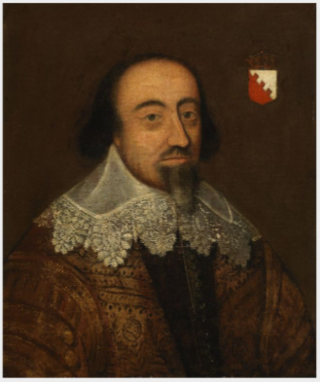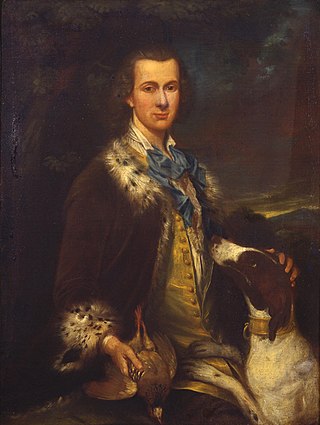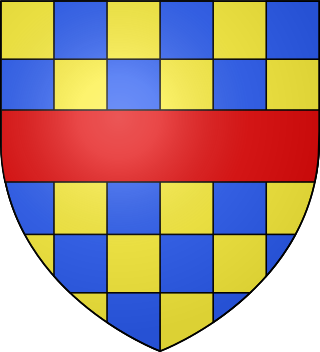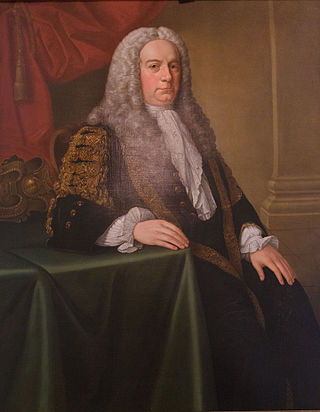
Richard Boyle, 1st Earl of Cork, also known as the Great Earl of Cork, was an English politician who served as Lord Treasurer of the Kingdom of Ireland.

Earl of Cork is a title in the Peerage of Ireland, held in conjunction with the Earldom of Orrery since 1753. It was created in 1620 for Richard Boyle, 1st Baron Boyle. He had already been created Lord Boyle, Baron of Youghal, in the County of Cork, in 1616, and was made Viscount of Dungarvan, in the County of Waterford, at the same time he was given the earldom. These titles are also in the Peerage of Ireland.

Earl of Shrewsbury is a hereditary title of nobility created twice in the Peerage of England. The second earldom dates to 1442. The holder of the Earldom of Shrewsbury also holds the title of Earl of Waterford (1446) in the Peerage of Ireland and Earl Talbot (1784) in the Peerage of Great Britain. Shrewsbury and Waterford are the oldest earldoms in their peerages held by someone with no higher title, and as such the Earl of Shrewsbury is sometimes described as the premier earl of England and Ireland.

Marquess of Lansdowne is a title in the Peerage of Great Britain created in 1784, and held by the head of the Petty-Fitzmaurice family. The first Marquess served as Prime Minister of Great Britain.

Marquess Conyngham, of the County of Donegal, is a title in the Peerage of Ireland. It was created in 1816 for Henry Conyngham, 1st Earl Conyngham. He was the great-nephew of another Henry Conyngham, 1st Earl Conyngham, a member of a family of Scottish descent which had settled during the Plantation of Ulster in County Donegal in Ireland in the early 17th century. The 'founder' of the dynasty in Ireland was The Very Rev. Dr. Alexander Cunningham, Dean of Raphoe. The earlier Henry was a member of both the Irish House of Commons and the British House of Commons and served as Vice-Admiral of Ulster and as Governor of the counties of Donegal and Londonderry. In 1753 he was raised to the Peerage of Ireland as Baron Conyngham, of Mount Charles in the County of Donegal, and in 1756 he was created Viscount Conyngham, in Ireland, also in the Peerage of Ireland. In 1781 he was made Baron Conyngham, of Mount Charles in the County of Donegal, with remainder to his nephew Francis Burton, and Earl Conyngham, of Mount Charles in the County of Donegal, which like the creations of 1753 and 1756 was created with normal remainder to the heirs male of his body. The latter titles were also in the Peerage of Ireland. Lord Conyngham was childless and on his death in 1781 the barony of 1753, the viscountcy and earldom became extinct while he was succeeded in the barony of 1781 according to the special remainder by his aforementioned nephew Francis. He was the eldest son of Mary, sister of the first Earl Conyngham, by her husband Francis Burton. The new 2nd Baron Conyngham, who had earlier represented Killybegs and County Clare in the Irish House of Commons, assumed by Royal licence the surname and arms of Conyngham on succeeding to the titles.

Earl of Scarbrough is a title in the Peerage of England. It was created in 1690 for Richard Lumley, 2nd Viscount Lumley. He is best remembered as one of the Immortal Seven who invited William of Orange to invade England and depose his father-in-law James II. Lumley had already been created Baron Lumley, of Lumley Castle in the County of Durham, in 1681, and Viscount Lumley, of Lumley Castle in the County of Durham, in 1689. These titles are also in the Peerage of England. The title of Viscount Lumley, of Waterford, was created in the Peerage of Ireland in 1628 for his grandfather Sir Richard Lumley, who later fought as a Royalist in the Civil War.
Earl Fortescue is a title in the Peerage of Great Britain that was created in 1789 for Hugh Fortescue, 3rd Baron Fortescue (1753–1841), a member of parliament for Beaumaris and Lord-Lieutenant of Devon.

Earl of Kingston is a title in the Peerage of Ireland. It was created in 1768 for Edward King, 1st Viscount Kingston. The Earl holds the subsidiary titles Baron Kingston, of Rockingham in the County of Roscommon, Viscount Kingston, of Kingsborough in the County of Sligo, Baron Erris, of Boyle in the County of Roscommon, and Viscount Lorton, of Boyle in the County of Roscommon, also in the Peerage of Ireland. He is also a baronet in the Baronetage of Ireland. Between 1821 and 1869 the earls also held the title Baron Kingston, of Mitchelstown in the County of Cork, in the Peerage of the United Kingdom.

Earl of Limerick is a title that has been created twice in the Peerage of Ireland, associated first with the Dongan family, then with the Pery family. It should not be confused with the title Viscount of the City of Limerick held by the Hamilton family also Earls of Clanbrassil.

Earl of Shannon is a title in the Peerage of Ireland. It was created in 1756 for the prominent Irish politician Henry Boyle, who served as Speaker of the Irish House of Commons and as Chancellor of the Irish Exchequer. The earldom is named after Shannon Park in County Cork.

Earl of Clanwilliam is a title in the Peerage of Ireland. It was created in 1776 for John Meade, 1st Viscount Clanwilliam. The Meade family descends from Sir John Meade, who represented Dublin University and County Tipperary in the Irish House of Commons and served as Attorney-General to James, Duke of York. In 1703, he was created a Baronet, of Ballintubber in the County of Cork, in the Baronetage of Ireland. His eldest son, Pierce, the second Baronet, died unmarried at an early age and was succeeded by his younger brother Richard, the third Baronet. Richard represented Kinsale in the Irish Parliament.

Earl of Donoughmore is a title in the Peerage of Ireland. It is associated with the Hely-Hutchinson family. Paternally of Gaelic Irish descent with the original name of Ó hÉalaighthe, their ancestors had long lived in the County Cork area as allies of the Mac Cárthaigh clan; they lost out during the times of Oliver Cromwell. One branch of the family converted to the Anglican Church and after inheriting territories through his mother and adding "Hutchinson" to Hely, became the Earl of Donoughmore.

Earl of Burlington is a title that has been created twice, the first time in the Peerage of England in 1664 and the second in the Peerage of the United Kingdom in 1831. Since 1858, Earl of Burlington has been a courtesy title used by the dukes of Devonshire, traditionally borne by the duke's grandson, who is the eldest son of the duke's eldest son, the marquess of Hartington.

Roger Boyle, 1st Earl of Orrery, 25 April 1621 to 16 October 1679, was an Anglo-Irish soldier and politician. A younger son of the Earl of Cork, the largest landowner in Munster, like many Irish Protestants he supported the Dublin Castle administration during the Irish Confederate Wars, a related conflict of the Wars of the Three Kingdoms.
Viscount Blesington, in the County of Wicklow, was a title in the Peerage of Ireland. It was created on 23 August 1673 for Murrough Boyle. He was the son of Michael Boyle, Archbishop of Armagh, eldest son of Richard Boyle, Archbishop of Tuam. He was created Baron Boyle, in the County of Wicklow, at the same time, also in the Peerage of Ireland. Both titles were created with remainder to the heirs male of his father. However, the titles became extinct on the death of his son, Charles, the second Viscount, on 2 June 1732.

Baron Clifford is a title in the Peerage of England created by writ of summons on 17 February 1628 for Henry Clifford, the heir of Francis Clifford, 4th Earl of Cumberland. Francis was believed to hold the Barony de Clifford, created in 1299, which could therefore be used to give Henry a seat in the House of Lords during his father's lifetime via a writ of acceleration. However, it would later be determined that the barony had in fact passed to his niece, Lady Anne Clifford. The summons of 1628 therefore unintentionally created a new barony, held by Henry. In 1641, on his father's death, Henry inherited the earldom of Cumberland, which became extinct upon his own death in 1643.

Henry Boyle, 1st Earl of Shannon, PC (Ire), was an Anglo-Irish politician and peer who served as the speaker of the Irish House of Commons from 1733 to 1756. A prominent parliamentarian who sat for almost fifty years in the Parliament of Ireland, Boyle frequently defended Irish interests against British Crown officials, eventually leading to a legal crisis which saw him step down as speaker in return for a peerage.
John Lysaght, 1st Baron Lisle of Mountnorth, in the County of Cork, was an Irish peer in the Peerage of Ireland and a politician.
Francis Boyle, 1st Viscount Shannon (1623–1699) was a Privy Counsellor of Ireland and held the office of Governor of County Cork.
Arthur Jones, 2nd Viscount Ranelagh was an Irish peer and politician who sat in both the Irish House of Commons and the English House of Commons.









